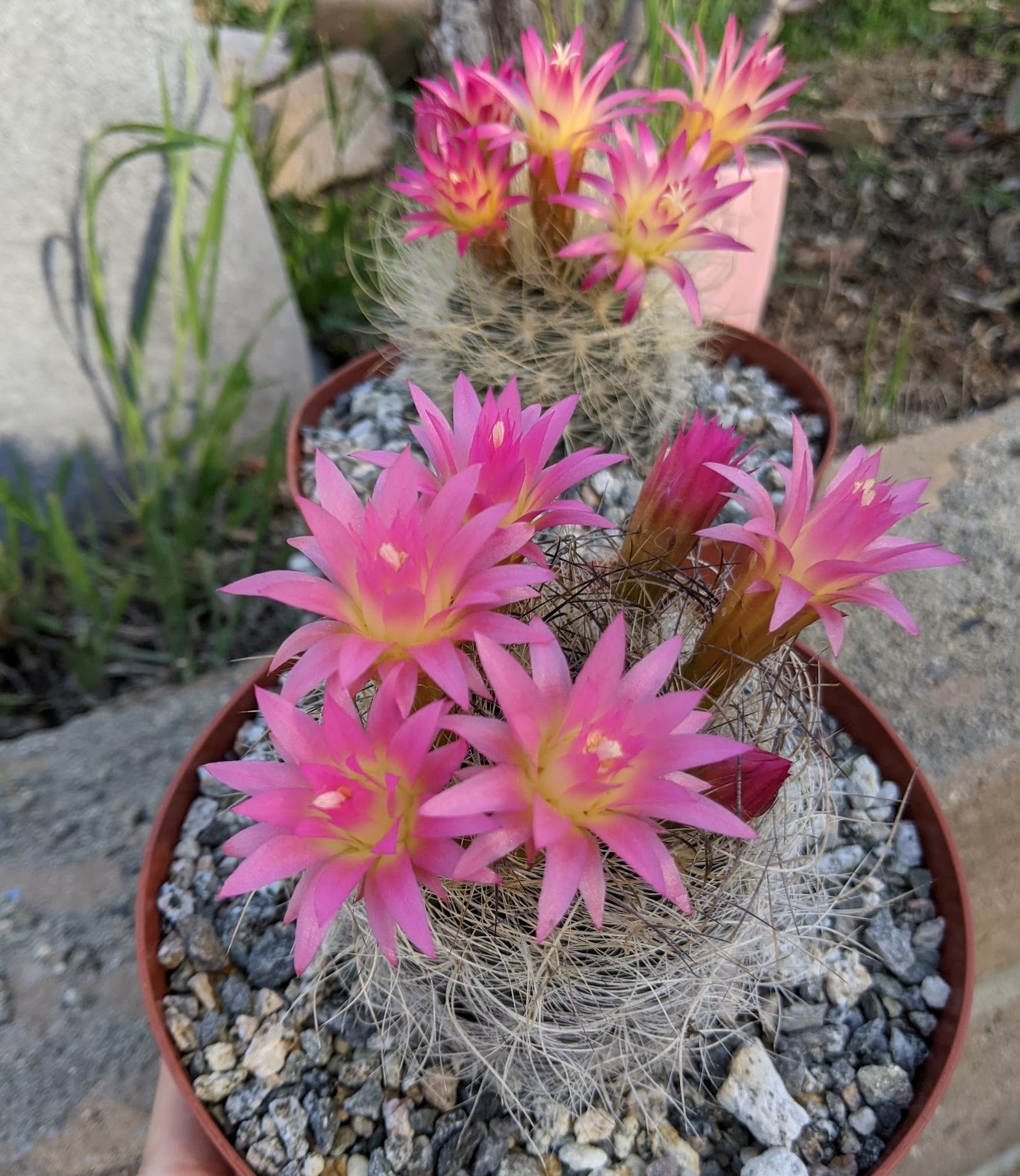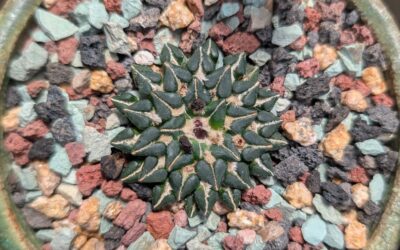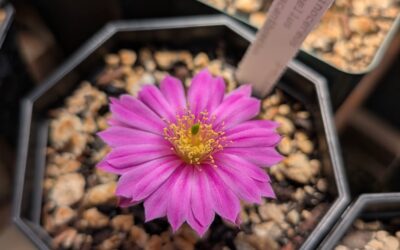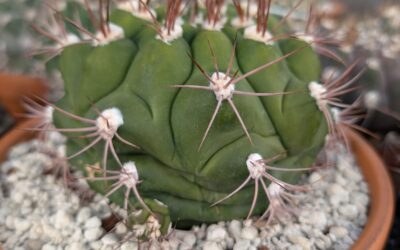Neoporteria or Eriocyse senilis is a goofy, frizzy looking cactus that is easy to grow, stays small, and produces the biggest display of brilliant flowers I’ve ever seen. They’re uncommonly available, and are listed under either genus.
They’re very variable, and have numerous names that represent local phenotypes. I have two distinct looking phenotypes – dark spined and light spined, although both produce the yellow centered, bright pink flowers characteristic of var. multicolor.
The body of the cacti should be deep purple, although they will fade to a deep green if kept somewhere with too much shade.
Dark spined Neoporteria senilis var. multicolor, showing off the gorgeous blooms that give it the name.
Photo from February 2021.
Basic Care for Neoporteria senilis
These are such delightful, easy to care for little cacti that I think everyone should have at least one in their collection. They’re hardy, forgiving, and stay small enough to be easy to manage. Mature specimens are rarely larger around than 3 – 4″, and over time can reach about 7″ tall.
Soil:
Pot these in a well draining mix – I prefer to add at least 25% more pumice to a typical quality cactus & succulent soil, but you can go with an even higher ratio if you know you’re heavy on the watering frequency.
Drainage is essential, as without it their roots will quickly rot. Don’t over-pot them, either, as excess room in the pot is a recipe for soggy soil to sit long enough to cause problems.
Light Requirements
Like most cacti, these require at least a few hours of direct sun. They look their best with dark purple bodies if they get at least 4 – 6 hours of morning sunlight, although I have mine all out in nearly full sun for the majority of the day. They are partially sheltered by the metal grate of the racks I have them in, but direct sun hits them for most of the day.
They also thrive with heat, and are summer growers, so as soon as your weather warms up outdoors and you can keep them sheltered from regular rainfall….stick em out for some nice, hot, sunshine! The dense spines help protect the body of the cactus from sunburn, but you should still strive to slowly acclimate a newly acquired greenhouse-grown plant to full sun.
Getting pumice out of the spines can take ages if you drop the cactus or spill soil on them, so keep that in mind when it comes to where you place them.
Photo from October 2020
Watering your Neoporteria
One of the things I appreciate about these cacti is that with a nice, fast-draining soil mix, you can water them pretty freely in summer as long as it’s warm and sunny. When temperatures are in the 70s and 80s, or above, and it’s bright and sunny outside, they’ll happily take water as soon as their soil dries out.
For me, last summer that was nearly every other day during the height of summer, and more like once a week when it was in the 80s on average.
In winter, you should keep them pretty much dry for the entire season, because, you guessed it, the roots will rot. If you keep them dry, they are hardy to the mid 20s F, but protect them actually freezing. That being said, I’ve left mine exposed to our San Diego winter weather, and even with our rain they have done fine. I did tarp and protect them from heavy rain and hail storms, but only needed to do so once.
If you’re feeling generous, you can fertilize with a high potassium fertilizer in summer, but it’s not really necessary, especially the first year after you repot them. These are small, unassuming little cacti that are quite easy. The most food I provide mine is leftover fish emulsion, well diluted, at the height of summer when I’ve been feeding my foliage plants.
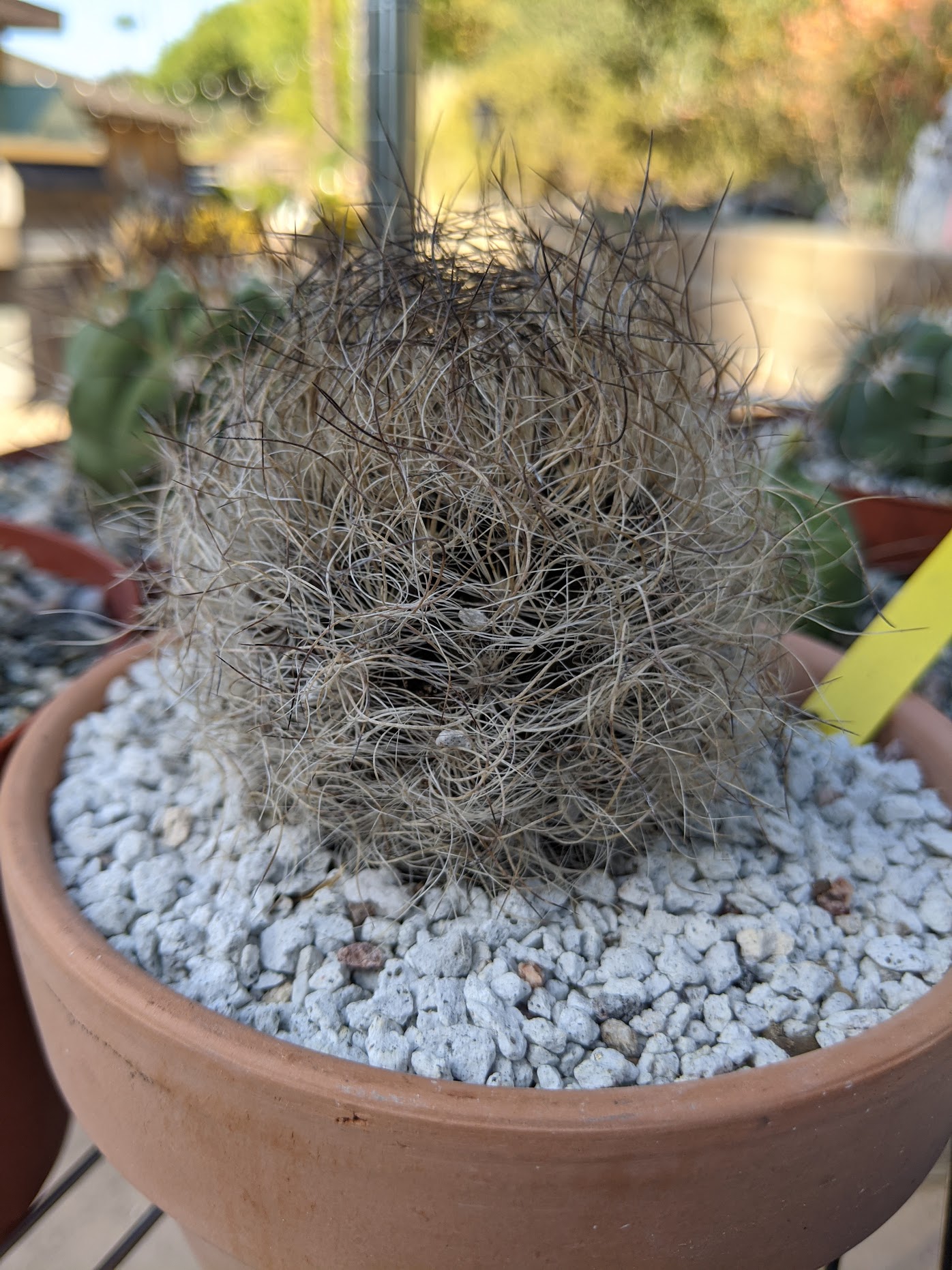
Neoporteria senilis var. multicolor in fall 2020
Blooming!
One of the best parts about growing these little cacti is their profuse number of brilliantly pink blooms, which can be an almost deep neon pink to a pale pink with yellow centers. They must have some additional shade or reflective capability within the flowers, because they are just a level of brilliant that you can’t capture in a photo and you can’t help but be drawn to them in a collection.
They bloom in spring, and for me, it’s pretty reliably in mid to late March and into April. My other Neoporteria bloom all through summer as well, but this will be my first full year with these so we’ll see how they do.
They are absolutely an easy to care for and undemanding cactus, and one I highly recommend to new cactus collectors!


